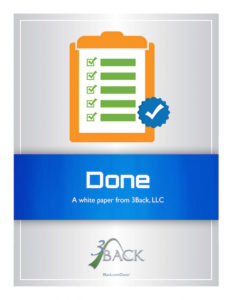 As work becomes more complex and involved, many Agile Teams frequently find themselves immersed in an interesting mix of projects where it is not obvious how to “Get to Done.” These Teams are challenged with the deceptively simple question: What does “Done” mean and how will I know when I am finished?
As work becomes more complex and involved, many Agile Teams frequently find themselves immersed in an interesting mix of projects where it is not obvious how to “Get to Done.” These Teams are challenged with the deceptively simple question: What does “Done” mean and how will I know when I am finished?
What if there were a fundamental equation that Teams could use to seamlessly answer that question?
There is. And you’ll find it in our newest white paper, aptly titled, Done.
The following is an excerpt from Done:
Let’s consider a common question facing many Teams today, get it done? Or Get to Done?. What is the difference between to and it? How does framing the question with to or it shift attention? What change in awareness does it cause?
The word to is meant to cause a lifting of the eyes and focus on the horizon. The word to implies a journey. The word it typically focuses our eyes at our feet and reduces consideration of where we are going and why. The ability to shift attention to the framing of the question causes a change in awareness and how we think about our work. The shift in awareness is nothing new, we have many phrases in common use that cause this shift. For example, “look before you leap,” “start with the end in mind,” “if you don’t know where you are going, anywhere will do,” “test driven development,” “interface first,” “the answer is 42, what does that mean,” etc.

When the work being done is trivial, the shift in awareness caused by to is unnecessary and often in the way of simply doing the job. As Getting to Done becomes more complex and involved, we find often find ourselves in an interesting mix of work that is not obvious on how to Get to Done. Now that shift in awareness is helpful. Then our simple equation for Getting to Done becomes a useful model which can help us pick apart complex work.
- AC – typically comes from users or clients
- SoC – brought by professionals who know how to do their job
- TN – a good Team will bring a good working relationship
- GA – boundaries, constraints, and guidance on how we approach the work
- DD – must be used along the way to ensure thoroughness and quality
- DoD – what we meet by doing all the little parts
Discover the real-world equation for Done and learn to detect and engage in the right conversations at the right time.
As Always, Stay Agile.

